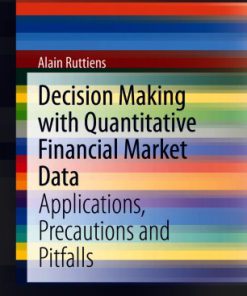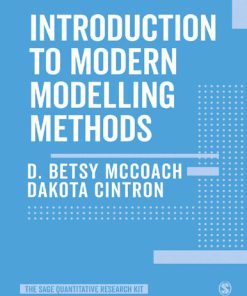An Introduction to Management Science: Quantitative Approaches to Decision Making, 16e 16th Edition by Jeffrey D. Camm 9780357715468 0357715462
$50.00 Original price was: $50.00.$25.00Current price is: $25.00.
An Introduction to Management Science: Quantitative Approaches to Decision Making, 16e 16th Edition Jeffrey D. Camm – Ebook Instant Download/Delivery ISBN(s): 9780357715468, 0357715462

Product details:
- ISBN 10: 0357715462
- ISBN 13: 9780357715468
- Author: Jeffrey D. Camm
An Introduction to Management Science: Quantitative Approaches to Decision Making
Table contents:
Chapter 1. Introduction
1.1. Problem Solving and Decision Making
1.2. Quantitative Analysis and Decision Making
1.3. Quantitative Analysis
Model Development
Data Preparation
Model Solution
Report Generation
A Note Regarding Implementation
1.4. Models of Cost, Revenue, and Profit
Cost and Volume Models
Revenue and Volume Models
Profit and Volume Models
Breakeven Analysis
1.5. Management Science Techniques
Methods Used Most Frequently
Summary
Glossary
Problems
Case Problem: Scheduling a Youth Soccer League
Appendix 1.1: Using Excel for Breakeven Analysis
Chapter 2. An Introduction to Linear Programming
2.1. A Simple Maximization Problem
Problem Formulation
Mathematical Statement of the Par, Inc., Problem
2.2. Graphical Solution Procedure
A Note on Graphing Lines
Summary of the Graphical Solution Procedure for Maximization Problems
Slack Variables
2.3. Extreme Points and the Optimal Solution
2.4. Computer Solution of the Par, Inc., Problem
Interpretation of Computer Output
2.5. A Simple Minimization Problem
Summary of the Graphical Solution Procedure for Minimization Problems
Surplus Variables
Computer Solution of the M&D Chemicals Problem
2.6. Special Cases
Alternative Optimal Solutions
Infeasibility
Unboundedness
2.7. General Linear Programming Notation
Summary
Glossary
Problems
Case Problem 1: Workload Balancing
Case Problem 2: Production Strategy
Case Problem 3: Hart Venture Capital
Appendix 2.1. Solving Linear Programs with Excel Solver
Chapter 3. Linear Programming: Sensitivity Analysis and Interpretation of Solution
3.1. Introduction to Sensitivity Analysis
3.2. Graphical Sensitivity Analysis
Objective Function Coefficients
Right-Hand Sides
3.3. Sensitivity Analysis: Computer Solution
Interpretation of Computer Output
Cautionary Note on the Interpretation of Dual Values
The Modified Par, Inc., Problem
3.4. Limitations of Classical Sensitivity Analysis
Simultaneous Changes
Changes in Constraint Coefficients
Nonintuitive Dual Values
3.5. The Electronic Communications Problem
Problem Formulation
Computer Solution and Interpretation
Summary
Glossary
Problems
Case Problem 1. Product Mix
Case Problem 2. Investment Strategy
Appendix 3.1. Sensitivity Analysis with Excel Solver
Chapter 4. Linear Programming Applications in Marketing, Finance, and Operations Management
4.1. Marketing Applications
Media Selection
Marketing Research
4.2. Financial Applications
Portfolio Selection
Financial Planning
4.3. Operations Management Applications
A Make-or-Buy Decision
Production Scheduling
Workforce Assignment
Blending Problems
Summary
Problems
Case Problem 1: Planning an Advertising Campaign
Case Problem 2: Schneider’s Sweet Shop
Case Problem 3: Textile Mill Planning
Case Problem 4: Workforce Scheduling
Case Problem 5: Duke Energy Coal Allocation
Appendix 4.1. Excel Solution of Hewlitt Corporation Financial Planning Problem
Chapter 5. Advanced Linear Programming Applications
5.1. Data Envelopment Analysis
Evaluating the Performance of Hospitals
Overview of the DEA Approach
DEA Linear Programming Model
Summary of the DEA Approach
5.2. Revenue Management
5.3. Portfolio Models and Asset Allocation
A Portfolio of Mutual Funds
Conservative Portfolio
Moderate Risk Portfolio
5.4. Game Theory
Competing for Market Share
Identifying a Pure Strategy Solution
Identifying a Mixed Strategy Solution
Summary
Glossary
Problems
Chapter 6. Distribution and Network Models
6.1. Supply Chain Models
Transportation Problem
Problem Variations
A General Linear Programming Model
Transshipment Problem
6.2. Assignment Problem
Problem Variations
A General Linear Programming Model
6.3. Shortest-Route Problem
A General Linear Programming Model
6.4. Maximal Flow Problem
6.5. A Production and Inventory Application
Summary
Glossary
Problems
Case Problem 1: Solutions Plus
Case Problem 2: Supply Chain Design
Appendix 6.1. Excel Solution of Transportation, Transshipment, and Assignment Problems
Chapter 7. Integer Linear Programming
7.1. Types of Integer Linear Programming Models
7.2. Graphical and Computer Solutions for an All-Integer Linear Program
Graphical Solution of the LP Relaxation
Rounding to Obtain an Integer Solution
Graphical Solution of the All-Integer Problem
Using the LP Relaxation to Establish Bounds
Computer Solution
7.3. Applications Involving 0-1 Variables
Capital Budgeting
Fixed Cost
Distribution System Design
Bank Location
Product Design and Market Share Optimization
7.4. Modeling Flexibility Provided by 0-1 Integer Variables
Multiple-Choice and Mutually Exclusive Constraints
k Out of n Alternatives Constraint
Conditional and Corequisite Constraints
A Cautionary Note about Sensitivity Analysis
Summary
Glossary
Problems
Case Problem 1. Textbook Publishing
Case Problem 2. Yeager National Bank
Case Problem 3. Production Scheduling with Changeover Costs
Case problem 4. Applecore Children’s Clothing
Appendix 7.1. Excel Solution of Integer Linear Programs
Chapter 8. Nonlinear Optimization Models
8.1. A Production Application—Par, Inc., Revisited
An Unconstrained Problem
A Constrained Problem
Local and Global Optima
Sensitivity Analysis
8.2. Constructing an Index Fund
8.3. Markowitz Portfolio Model
8.4. Blending: The Pooling Problem
8.5. Forecasting Adoption of a New Product
Summary
Glossary
Problems
Case Problem 1: Portfolio Optimization with Transaction Costs
Case Problem 2: Cafe Compliance in the Auto Industry
Appendix 8.1. Solving Nonlinear Optimization Problems with Excel Solver
Chapter 9. Project Scheduling: PERT/CPM
9.1. Project Scheduling Based on Expected Activity Times
The Concept of a Critical Path
Determining the Critical Path
Contributions of PERT/CPM
Summary of the PERT/CPM Critical Path Procedure
9.2. Project Scheduling Considering Uncertain Activity Times
The Daugherty Porta-Vac Project
Uncertain Activity Times
The Critical Path
Variability in Project Completion Time
9.3. Considering Time–Cost Trade-Offs
Crashing Activity Times
Linear Programming Model for Crashing
Summary
Glossary
Problems
Case Problem 1. R. C. Coleman
Appendix 9.1. Finding Cumulative Probabilities for Normally Distributed Random Variables
Chapter 10. Inventory Models
10.1. Economic Order Quantity (EOQ) Model
The How-Much-to-Order Decision
The When-to-Order Decision
Sensitivity Analysis for the EOQ Model
Excel Solution of the EOQ Model
Summary of the EOQ Model Assumptions
10.2. Economic Production Lot Size Model
Total Cost Model
Economic Production Lot Size
10.3. Inventory Model with Planned Shortages
10.4. Quantity Discounts for the EOQ Model
10.5. Single-Period Inventory Model with Probabilistic Demand
Neiman Marcus
Nationwide Car Rental
10.6. Order-Quantity, Reorder Point Model with Probabilistic Demand
The How-Much-to-Order Decision
The When-to-Order Decision
10.7. Periodic Review Model with Probabilistic Demand
More Complex Periodic Review Models
Summary
Glossary
Problems
Case Problem 1. Wagner Fabricating Company
Case Problem 2. River City Fire Department
Appendix 10.1. Development of the Optimal Order Quantity ( Q ) Formula for the EOQ Model
Appendix 10.2. Development of the Optimal Lot Size ( Q ) Formula for the Production Lot Size Model
Chapter 11. Waiting Line Models
11.1. Structure of a Waiting Line System
Single-Server Waiting Line
Distribution of Arrivals
Distribution of Service Times
Queue Discipline
Steady-State Operation
11.2. Single-Server Waiting Line Model with Poisson Arrivals and Exponential Service Times
Operating Characteristics
Operating Characteristics for the Burger Dome Problem
Managers’ Use of Waiting Line Models
Improving the Waiting Line Operation
Excel Solution of Waiting Line Model
11.3. Multiple-Server Waiting Line Model with Poisson Arrivals and Exponential Service Times
Operating Characteristics
Operating Characteristics for the Burger Dome Problem
11.4. Some General Relationships for Waiting Line Models
11.5. Economic Analysis of Waiting Lines
11.6. Kendall’s Notation for Classifying Queueing Models
11.7. Single-Server Waiting Line Model with Poisson Arrivals and General Service Times
Operating Characteristics for the M/G/1 Model
Constant Service Times
11.8. Multiple-Server Model with Poisson Arrivals, General Service Times, and No Waiting Line
Operating Characteristics for the M/G/k Model with Blocked Customers Cleared
11.9. Waiting Line Models with Finite Calling Populations
Operating Characteristics for the M/M/1 Model with a Finite Calling Population
Summary
Glossary
Problems
Case Problem 1. Regional Airlines
Case Problem 2. Olympus Equipment, Inc.
Chapter 12. Simulation
12.1. What-If Analysis
Sanotronics
Base-Case Scenario
Worst-Case Scenario
Best-Case Scenario
12.2. Simulation of Sanotronics Problem
Use of Probability Distributions to Represent Random Variables
Generating Values for Random Variables with Excel
Executing Simulation Trials with Excel
Measuring and Analyzing Simulation Output
12.3. Inventory Simulation
Simulation of the Butler Inventory Problem
12.4. Waiting Line Simulation
Black Sheep Scarves
Customer (Scarf) Arrival Times
Customer (Scarf) Service (Inspection) Times
Simulation Model
Simulation of Black Sheep Scarves
Simulation with Two Quality Inspectors
Simulation Results with Two Quality Inspectors
12.5. Simulation Considerations
Verification and Validation
Advantages and Disadvantages of Using Simulation
Summary
Summary of Steps for Conducting a Simulation Analysis
Glossary
Problems
Case Problem 1. Four Corners
Case Problem 2. Harbor Dunes Golf Course
Case Problem 3. County Beverage Drive-Thru
Appendix 12.1. Common Probability Distributions for Simulation
Chapter 13. Decision Analysis
13.1. Problem Formulation
Influence Diagrams
Payoff Tables
Decision Trees
13.2. Decision Making without Probabilities
Optimistic Approach
Conservative Approach
Minimax Regret Approach
13.3. Decision Making with Probabilities
Expected Value of Perfect Information
13.4. Risk Analysis and Sensitivity Analysis
Risk Analysis
Sensitivity Analysis
13.5. Decision Analysis with Sample Information
Influence Diagram
Decision Tree
Decision Strategy
Risk Profile
Expected Value of Sample Information
Efficiency of Sample Information
13.6. Computing Branch Probabilities with Bayes’ Theorem
13.7. Utility Theory
Utility and Decision Analysis
Utility Functions
Exponential Utility Function
Summary
Glossary
Problems
Case Problem 1. Property Purchase Strategy
Case Problem 2. Lawsuit Defense Strategy
Case Problem 3. Rob’s Market
Case Problem 4. College Softball Recruiting
Chapter 14. Multicriteria Decisions
14.1. Goal Programming: Formulation and Graphical Solution
Developing the Constraints and the Goal Equations
Developing an Objective Function with Preemptive Priorities
Graphical Solution Procedure
Goal Programming Model
14.2. Goal Programming: Solving More Complex Problems
Pérez Office Supplies Problem
Formulating the Goal Equations
Formulating the Objective Function
Computer Solution
14.3. Scoring Models
14.4. Analytic Hierarchy Process
Developing the Hierarchy
14.5. Establishing Priorities Using AHP
Pairwise Comparisons
Pairwise Comparison Matrix
Synthesization
Consistency
Other Pairwise Comparisons for the Car Selection Problem
14.6. Using AHP to Develop an Overall Priority Ranking
Summary
Glossary
Problems
Case Problem 1. Banh Trailers, Inc.
Appendix 14.1. Scoring Models with Excel
Chapter 15. Time Series Analysis and Forecasting
15.1. Time Series Patterns
Horizontal Pattern
Trend Pattern
Seasonal Pattern
Trend and Seasonal Pattern
Cyclical Pattern
Selecting a Forecasting Method
15.2. Forecast Accuracy
15.3. Moving Averages and Exponential Smoothing
Moving Averages
Weighted Moving Averages
Exponential Smoothing
15.4. Linear Trend Projection
15.5. Seasonality
Seasonality Without Trend
Seasonality with Trend
Models Based on Monthly Data
Summary
Glossary
Problems
Case Problem 1. Forecasting Food and Beverage Sales
Case Problem 2. Forecasting Lost Sales
Appendix 15.1. Forecasting with Excel Data Analysis Tools
Appendix 15.2. Using the Excel Forecast Sheet
Chapter 16. Markov Processes
16.1. Market Share Analysis
16.2. Accounts Receivable Analysis
Fundamental Matrix and Associated Calculations
Establishing the Allowance for Doubtful Accounts
People also search:
an introduction to management science
an introduction to management science 15th edition
an introduction to management science 16th edition pdf
an introduction to management science 16th edition
an introduction to management science 15th edition solutions
You may also like…
Business & Economics - Management & Leadership
An Introduction to Management Science: Quantitative Approach 15th Edition David R. Anderson
Business & Economics - Markets
Politics & Philosophy - Others
Computers - Computer Graphics & Design
Data Visualization: Exploring and Explaining with Data by Jeffrey D. Camm 9798214341378
Earth Sciences - Geography
Uncategorized
Politics & Philosophy - Politics
Power and Choice An Introduction to Political Science 16th Edition W. Phillips Shively












